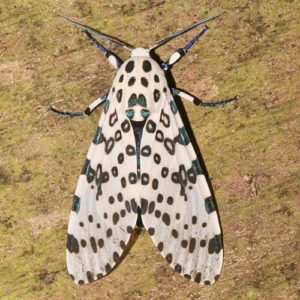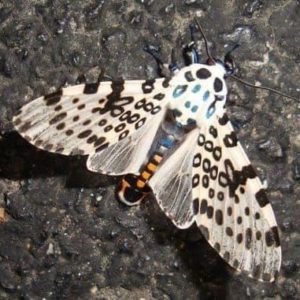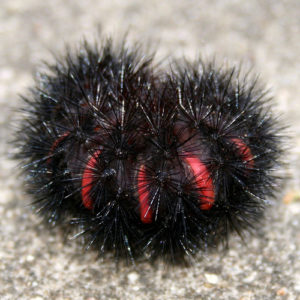The giant leopard moth (Hypercompe scribonia) can be found throughout most of the eastern United States. It is a beautiful moth that is fairly easy to observe. Giant leopard moths also have some surprising characteristics that make them fun to learn about.
What does it look like?

Adult
Adults are medium sized moths. The males are quite a bit bigger than the females. Males are about 2 inches long and have an approximately 3.5-inch wingspan. Females, on the other hand, are only about 1.5 inches long with a little over a 2-inch wingspan.
The wings of a giant leopard moth are bright white and covered with black circles. The centers of the circles can be white, black, or an iridescent blue. The abdomen has a beautiful pattern of black, orange, and iridescent blue, but it is often covered by the wings.
Caterpillar
The caterpillars look like big, black wooly worms / wooly bears with red stripes on the body underneath the bristly “hairs.” (The red stripes are most noticeable when the caterpillar curls up.) There’s a good reason for why they are reminiscent of black wooly worms / wooly bears. Giant leopard moths are in the tiger moth tribe of moths – the same tribe as the wooly worms / wooly bears. Although they are often mistaken for their cousins, giant leopard moth caterpillars are always black, and thus, aren’t indicators of a potentially harsh winter.
Basic biology and life history of the giant leopard moth
Giant leopard moths only live a few days as an adult. During that time, their sole purpose is to mate and, in the case of the female, lay eggs. Most of the giant leopard moth’s life is spent as a caterpillar. The caterpillars are primarily active at night and are feeding machines. In northern regions, there is only one generation of giant leopard moths each year. In more southern regions, there can be two, or possibly more, generations each year. Adults can be found flying in some part of their range from early spring through late fall.
In the fall, almost fully mature caterpillars begin searching for a place to overwinter in fallen leaves, wood piles, etc. They can sometimes be seen crossing roads at this time, and are often mistaken for their cousins, which are also searching for similar overwintering sites. As the weather starts to warm up in the spring, the giant leopard moth caterpillars will seek out a few final meals before forming a cocoon and then metamorphosing into an adult moth. Because they overwinter as an almost mature caterpillar, adults can be seen as early as late March or early April in warmer areas.

Adult giant leopard moths have some interesting anti-predatory adaptations. If they are threatened while resting, they will often curl their abdomen so that the bright colorations show. It may also exude a yellow liquid from its thorax. One reference I found said that the liquid had a bitter taste. I’m not going to ask how they know that.
However, the most interesting anti-predatory adaptation giant leopard moths have is an ear located at the base of their hind wings. This ear allows them to detect the echolocation calls of bats. Presumably if they can detect the calls, then they have a chance at avoiding the bat and becoming its lunch.
As a side note, sometimes when you jingle a set of keys near moths that can detect ultrasonic calls, the moths will suddenly tuck their wings and fall towards the ground. The jingling of the keys produces ultrasonic sounds that we can’t hear, but the moths can. The keys jingling doesn’t sound anything like a real bat’s calls, but the moths don’t take time to “think” about that. Thinking that a bat may have snuck up on them, they quickly try to avoid the potential bat by dropping quickly to the ground. I haven’t tried it with giant leopard moths and the key jingling trick doesn’t always work, but it might be fun to try.
Giant leopard moth caterpillars have their own set of anti-predatory adaptations. Like their wooly worm / wooly bear cousins, the bristly hairs that cover the older giant leopard moth caterpillars’ bodies aren’t poisonous. Instead, when threatened the caterpillars will curl up into a tight ball. This flares the hairs and exposes the red bands underneath. Red is typically a warning color and it is assumed that giant leopard moth caterpillars have some level of chemical protection. Plus, I can’t imagine a mouthful of bristly hairs would feel too great even if they don’t sting or the caterpillar doesn’t have other chemical protections.
Diet
Adult
Like many other species of moths, giant leopard moths don’t eat as adults. Their mouths aren’t even fully formed. Instead, they live off the fat reserves they stored as a caterpillar.

Caterpillar
The caterpillars are generalists and eat a wide variety of plants. Examples of some of the plants they are known to feed on are cabbage, cherry trees, violets, plantain, sunflowers, magnolias, willows, dandelions, and many others. Scientists aren’t sure if they even have a complete list of everything on the giant leopard moth caterpillar’s diet.
Attracting and observing the giant leopard moth
Having some of the many different host plants for the caterpillars nearby helps to increase your chances of having giant leopard moths in your yard. In the fall, leaving your leaves in at least part of your property so that the caterpillars have a place to overwinter will also increase your chances of having giant leopard moths around your home. In addition to overwintering in fallen leaves, the caterpillars will also sometimes overwinter in wood piles or similar protected spaces.
The easiest way to observe the adult giant leopard moths is to turn on a light. Male giant leopard moths are strongly attracted to lights; females, not so much. If you have a porch light on, try looking around it. You could also look around windows where you haven’t pulled the curtains so light from inside the house is spilling out into the night. Another option is to hang a sheet and shine a bright light on it. More details about that can be found in my mothing article.
Don’t forget to turn off all the lights, or pull the curtains, when you are done trying to observe giant leopard moths. Attracting them to the lights keeps them from going about their important business of creating the next generation of giant leopard moths.
Please tell your friends about Backyard Ecology.
(Social media sharing buttons can be found below the footer.)

Backyard Ecology: Exploring Nature in Your Backyard
Nature isn’t just “out there.” It’s all around us, including right outside our doors. Hi, my name is Shannon Trimboli, and I am the host of Backyard Ecology. I live in southcentral Kentucky and am a wildlife biologist, educator, author, beekeeper, and owner of a nursery specializing in plants for pollinators and wildlife conservation. I invite you to join me as we ignite our curiosity and natural wonder, explore our yards and communities, and improve our local pollinator and wildlife habitat. Learn more or subscribe to my email list at www.backyardecology.net.

Leave a Reply